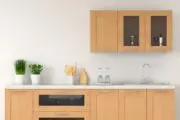When I was 19, I moved into a semi-basement apartment off a cobblestoned side alley in Montreal. Opening the front door for the first time, a neglected plant caught my eye. It had clearly been left behind by the previous tenant. Underwatered, tucked away in a dark corner and miraculously still alive, I was charmed. I would come to learn this plant was a pothos, and it single-handedly sparked a decade-running obsession with plants (especially the low-light, low-care variety).
If bright natural light isn’t one of your home’s winning features or you have a self-proclaimed black thumb, you may have already come to the somber conclusion that lavish indoor gardens aren’t in the cards for you. Well, it’s time to turn a new leaf. There are dozens of plants that actually crave dark corners and some even thrive on neglect. With over ten years of experience as a dedicated plant parent with less-than-ideal interior light sources, I’ve discovered these eight favorites. Let’s dig in.

How to read your light source
To a certain degree, we can apply some common sense here. Does the room feel dark or bright?
That said, when you research the light requirements for a specific plant, you’ll encounter terms like ‘requires bright indirect light,’ ‘wants low-to-medium light,’ ‘loves direct light’ that can make it feel complicated.
So, how do you figure out which is which? The answer is to look at the direction your window is facing. Then assess if there is anything blocking the light source — a tall building in front of your condo or a sheer curtain over the windows. If there is nothing blocking the light rays from landing on your plants, it’s direct light. You’ll typically find bright indirect light in an east- or north-facing room or in a west- or south-facing room with something obscuring the window (like a big tree in front of it).
- If your window faces north, you will never get direct light. The room may feel relatively bright, but plants that require high light will never make it in here. Low-to-medium light plants are your jam.
- If your window faces east, this means you get morning light. It’s a colder light and disappears as the sun hits the halfway mark in the sky. Low-to-medium light plants will do great here.
- If your room faces south — congrats — you won the plant light lottery. You get hours and hours of bright light a day. You can put a light-thirsty cactus right up against the window and it’ll rock out. Across the room, you can put a low light plant in the corner.
- If your room faces west, you also have a bright room, with hot light coming in as the sun is setting. Almost every plant on this list hates direct light. Be careful not to put them up against a west window, as it’ll burn the leaves. As long as you’re strategic with your placement, a huge variety of plants will thrive in a west-facing room.
Keep in mind, you can have different light sources in the same room. Just because you have a south-facing window, doesn’t mean you can put any plant anywhere you please. Say you have a bed in the middle of the room. On the left side, there’s a window where bright light floods in. But you want to put the plant on the floor beside the right side of the bed, where it’s obscured by the mattress. Now, only a lower-light plant will work here.

Every plant needs some natural light to survive.
You can’t put low-light plants in a windowless room and expect them to thrive. At best, they will live for a few months and suffer a slow, sad death. The light from a standard bulb does nothing for them (unless you purchase grow lights that are designed for the purpose of feeding your plants).
If you don’t have any windows in a room but you’re determined to keep plants in there, you can take your plant out and field trip it around the apartment, moving them near the light source in the day and putting them back in the room at night. Aside from the annoyance of doing this, plants are homebodies that don’t love being shuffled around all the time. If they are constantly going from bright light to no light, they can go into shock.
If you’ve determined you have at least some semblance of a light source, start with these eight plants to grow your collection:
1. Snake Plants

The snake plant, also known as mother-in-law’s tongue or ribbon plant, is near-indestructible. They have thick, waxy leaves and come in the form of small table plants or large floor plants. They love being potbound and relish in having their soil dry out between waterings. Planning a two-week vacation? Wish your snake plant ‘bon voyage’ — it’ll look exactly the same when you get home.
Light: They can tolerate the darkest corner to the brightest window.
Water: Overwatering your snake plants can be fatal. Allow the soil to completely dry out between waterings. In a particularly dark spot in the winter, you can go an entire month without water. In a brighter spot, give them a sip every 14 days.
2. Zanzibar Gems

This is my favorite plant, hands down. Part of the succulent family, ZZ’s are almost impossible to kill. They have long stems that are covered in hundreds of thick, waxy, polished leaves. They’re native to Eastern Africa and are extremely drought resistant. They store water in their roots, so if you forget one or two waterings, they will wholeheartedly forgive you.
Light: ZZ’s will thrive in low to bright indirect let. Don’t put this plant in direct sun — it’ll burn the leaves.
Water: ZZ’s hate to be overwatered. Allow to thoroughly dry out between waterings (about every 10-14 days). While not universal, if the leaves start going yellow, you probably went a little water-crazy.
3. Prayer Plant

Prayer plants have hues of red, green, brown and cream in the leaves that almost look as if they were hand-painted. They get their name because the leaves recess at night and rise in the morning, as if they were praying (this time lapse will blow your mind). Native to Brazil and countries in Asia and Africa, these plants do well in medium-light to bright indirect light (they’ll love your north and east-facing rooms).
Light: Prayer plants will thrive in medium to bright light, but will suffer in direct sun. When there isn’t enough light, the leaves close at night and remain slightly curled in the day. Too much light and the leaves start to lose their gorgeous pigment.
Water: Prayer plants don’t like to dry out between waterings. Ensure the soil is moist but never soggy.
4. Pothos

Being my first plant, I will always have a soft spot for pothos. I’m not alone. They are the perfect starter plant, and can stay alive for years in less than ideal conditions. As they grow, their leaves trail into vine that drapes happily over a bookshelf or hanging basket. They come in three colorways that require slightly different light requirements. A golden pothos has bright yellow leaves and requires the most light (medium light). A marble queen pothos has a blend of white and green leaves and grows best in medium-to-bright, indirect light. Jade pothos have solid green leaves that do well in low light.
Light: Low-to-bright indirect light, depending on the color of the leaves. Avoid putting a pothos in direct light, as it will burn the leaves.
Water: Water thoroughly and allow the soil to dry out halfway between waterings. If the leaves go limp, brown at the tips or yellow, it’s an indication that the plant has been underwatered.
5. Cast Iron Plant

The Cast Iron Plant got its name because, like a cast iron pan, they can’t be destroyed. Native to China, you can essentially do whatever you want with them. They’ll thrive in areas where other low-light plants would prevail but can also do well in bright light. They’re not too fussy if they get overwatered or underwatered. They’re basically the best.
Light: A Cast Iron Plant prefers low-light to bright, indirect light. When the light is too bright, the older leaves can turn brown.
Water: Water thoroughly and allow the soil to dry out halfway between waterings. In very low light, the plant may only need to be watered every two to three weeks.
6. Dumb Cane Plant

If you have small kids or pets, don’t bring this plant home. The leaves have microscopic crystals that will make your mouth feel swollen, if ingested. The name comes from losing your ability to speak. That said, these guys are low-light warriors. They can start as table plants and grow up to five feet in the right conditions (and if you’re willing to look past the bad rap).
Light: Dieffenbachia plants require medium-to-bright, indirect light. Direct sun burns the leaves and too much light causes the color to fade. They will be especially tolerant of partial shade in the summer. In the winter, move it closer to the light source.
Water: Allow the top two inches of soil to dry between waterings.
7. Peace Lily

Peace Lillies are beautiful indoor plants with large, glossy, oval leaves. They originated in tropical forests around the world where they were close to the forest floor and dappled in shade. They are one of the few plants that can flower in medium-to-low light. Like the Dumb Cane, this plant is poisonous and should be kept away from animals and children.
Light: They do well in low, medium or bright, indirect light. Direct sunlight burns the leaves.
Water: Water thoroughly and allow the soil to dry out halfway between waterings. Leaves turn a black-brown from overwatering.
8. Bird’s Nest Fern

Bird’s Nest Ferns are characterized by ripple-edged fronds that emerge from a central crown. When the new leaves first sprout, they resemble little bird eggs, which is where this plant gets its adorable name. This plant is pet-friendly.
Light: They do well in medium-to-bright indirect light. The distinctive bright green leaves become pale when exposed to too much light. Direct sun causes the leaves to burn.
Water: Water weekly. Bird’s nest ferns like to be evenly moist but never soggy.






